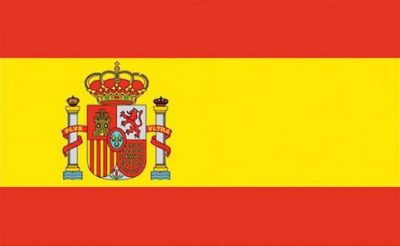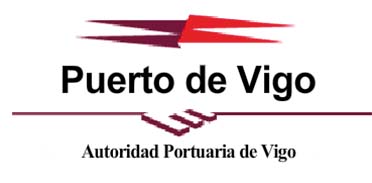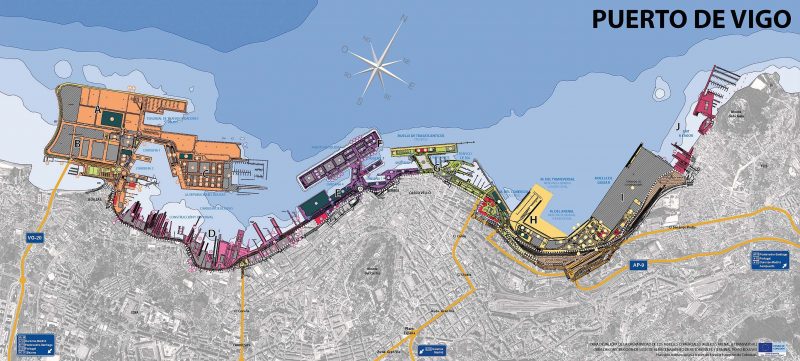
 The Ria de Vigo is one of the best natural harbours in the world, and is protected by the offshore Islas Cies with their jagged peaks. This ria is one of four rias in the area, with the Ria de Pontevedra the next ria to the north with a large Spanish Navy training base at Pontevedra, which is the capital of this part of Galicia. The rias are sometimes, misleading, compared to fjords. They cannot be compared to the grandeur of a stormy Norwegian fjord, as the surrounding hills are lower in height, and visually more serene, with cultivated crops down to the edge of the sea. Galicians love their Rias Bajas (Deep Rias), whether they have big cities like Vigo or whether they have been hardly touched by mankind.
The Ria de Vigo is one of the best natural harbours in the world, and is protected by the offshore Islas Cies with their jagged peaks. This ria is one of four rias in the area, with the Ria de Pontevedra the next ria to the north with a large Spanish Navy training base at Pontevedra, which is the capital of this part of Galicia. The rias are sometimes, misleading, compared to fjords. They cannot be compared to the grandeur of a stormy Norwegian fjord, as the surrounding hills are lower in height, and visually more serene, with cultivated crops down to the edge of the sea. Galicians love their Rias Bajas (Deep Rias), whether they have big cities like Vigo or whether they have been hardly touched by mankind.
The Port of Vigo is arrayed along the southern shoreline of the ria, with superb views of the bay and the surrounding green forest ridges. Vigo has a population of almost 300,000 and became the first Galician town to industrialise with the opening of several sardine canneries. It is now the chief fishing port of Spain with fish wharves stretching five kilometres along the shore. The original port was at Baiona (Bayona) and closer to the mouth of the ria until the arrival of the railways and the necessity of more protection from Atlantic storms. It was to Bayona on 10th March 1493 that the Pinta carrying Colon (Christopher Columbus) returned after his first voyage of exploration with the news that the New World had been discovered.
At the turn of the century in 1900 and subsequently, Spanish liners docked at the Estacion Maritima del Ria to embark generations of Spanish and Portuguese emigrants in large numbers seeking a new life in the Americas. Today, big cruise ships dock at the same berth with their visitors keen to see the sights of Vigo city, and well as the surrounding countryside, and to sample the excellent restaurants and superb tapas bars of El Berbes, the name for Old Vigo. Fresh fish is sold on the Rua de Pescaderia from the many trawlers unloading their catches every day. The cruise ship terminal is almost adjacent to the long Puerto Pesquero (Fish Port) of 1,400 feet in length in a central location on the Vigo waterfront, with the ro-ro terminal (Ensenada de Bouzas) to the south and the container terminal to the north.

History Of Vigo
The name of Vigo is derived from the Roman settlement of Vicus Spacorum, and ancient Phoenician and Greek seafarers also lived here. The twelfth century troubadour and poet Martin Codax and his friends waxed lyrical about the ria where their lovers bathed in the nude. Sir Francis Drake sacked the town twice in 1585 and 1589, and later in 1702 the English fleet surprised a joint Spanish and French treasure fleet of laden galleons returning from the Caribbean and destroyed eleven of them in the Battle of Vigo or Battle of Rande. The population grew rapidly due to the big fishing industry from 6,700 in 1842, to 23,200 in 1900, 137,873 in 1950, and now stands at 295,500 people. The huge fish market befitting the premier fish port in Spain down in the cobbled streets of El Berbes starts early at dawn from 0400 hours in summer with fish dealers vying with each other to purchase the best of the many types of Atlantic fish, together with oysters grown locally in the ria. Vigo lies within twenty miles of the Portuguese border to the south and the Rio Minho, where Spanish tramps were anchored as prison ships holding captured Republican troops and political prisoners at the end of the Spanish Civil War won by Franco and the Nationalists in 1939.
Subscribe today to read the full article!
Simply click below to subscribe and not only read the full article instantly, but gain unparalleled access to the specialist magazine for shipping enthusiasts.







Comments
Sorry, comments are closed for this item